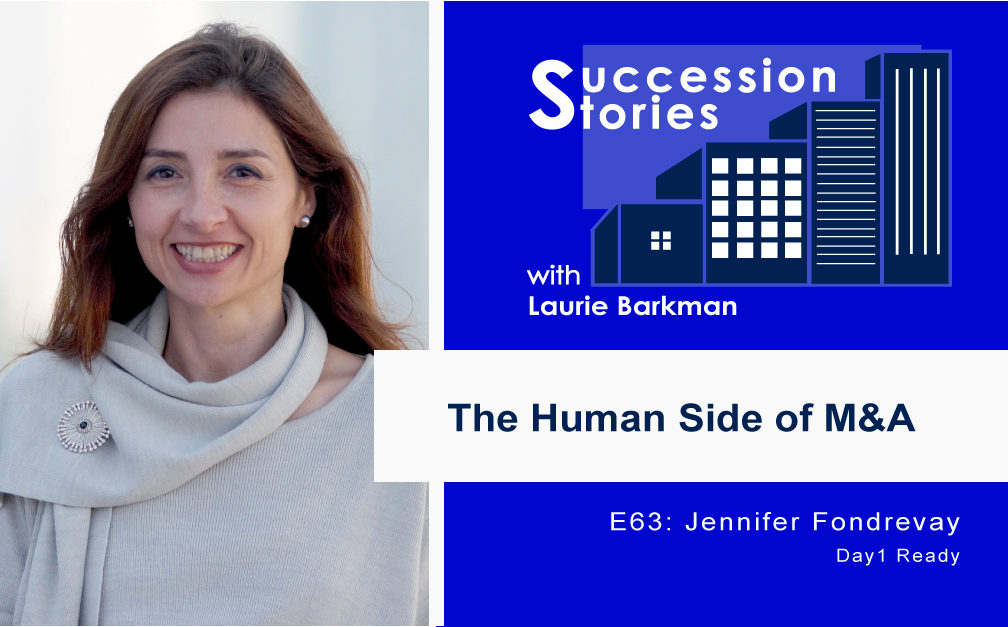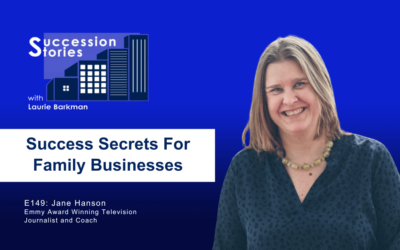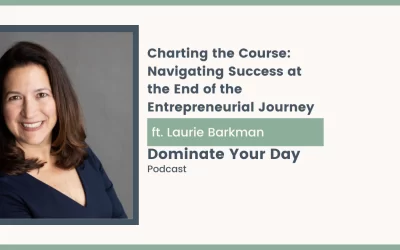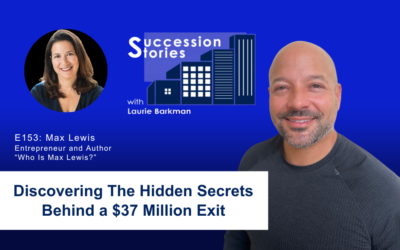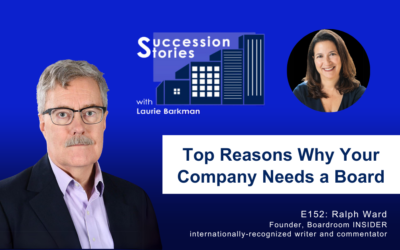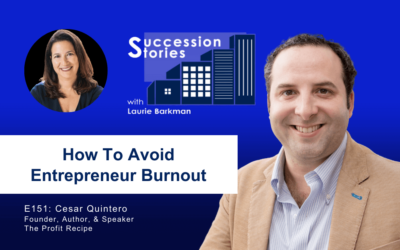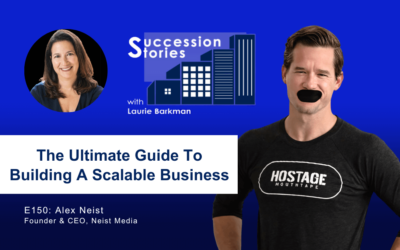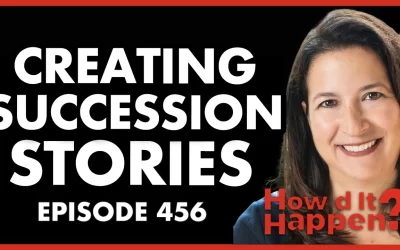Did you know that 80% of mergers and acquisitions fail? An often overlooked yet critical aspect of M&A deals and transitions is the people factor. Jennifer Fondrevay, Founder of Day1 Ready, advises senior executives on how to plan for expected challenges. Listen in as Laurie Barkman talks with Jennifer about the emotional aspect of business transition, and how those emotions come into play for a newly merged organization. If you’re anticipating a company transition in your future, listen in to learn more about how strategies around the human factor can drive greater success in M&A deals.
Listen in to learn more about:
- What to anticipate from your workforce when you announce an M&A deal
- Three key things to consider when buying or selling a business
- Benefits of a human capital-centric approach to M&A
- How to build confidence and synergy among different parties involved during a transition
Show Links:
Jennifer Fondrevay on LinkedIn
Harvard Business Review article
Podcast website: SuccessionStories.com
About:
The Succession Stories podcast is hosted by Laurie Barkman, Founder of SmallDotBig.
We’ll help you maximize business value, plan your exit transition, and get rewarded for all of your hard work by finding the right buyer.
Transcript:
Laurie Barkman:
Jennifer Fondrevay, thank you so much for joining me today. One of the amazing things about going digital for events is when you’re brought together with someone you haven’t met before, and that’s what happened with you and me. We met a few months ago, we were both invited to be panelists for the M&A community. We did a panel together and you and I just clicked immediately, I think, probably I’m guessing, for a few reasons. One is we have a shared background in C-suite marketing in corporate America, and we’re both now today in the M&A ecosystem and so that immediately kind of gave us this shared interest. One of the things that I thought was really interesting about the panel that you and I were on is how we talked about where deals can be successful and not successful. So as we enter into this conversation, just setting the stage that there’s a statistic out there that 80% of M&A – of mergers and acquisitions – ultimately fail. You and I are both on a mission to reverse that trend. So welcome.
Jennifer Fondrevay:
Thank you. Yeah, we bumped into each other virtually.
Laurie Barkman:
We did. A virtual meeting that led to other things, which is great. For me, and for you to help with setting the stage here for the conversation, I focus on the buy and the sell side and working primarily with business owners, both through value exit planning, transition planning, and then ultimately through the M&A transaction. What I love about you and your background is you’re optimizing the human side of the M&A transaction and your mission is to help make the deal and the transition successful.
So this crossroads, this people side of the deal, I know for me and my show, I’m excited to spotlight it today. It’s something that I haven’t had enough of on my show, and I think in general, and probably what you found is that we don’t talk about it enough and I think that’s a maybe a great place for you to start in sharing your background of what brought you from this corporate background, and C-suite marketing and advertising, to writing a book about mergers and acquisitions, and starting an M&A consultancy.
Jennifer Fondrevay:
After the first one, so the first acquisition I went through, Nokia acquired a company where I was working as the head of B2B marketing; Navteq digital mapmaker. That one is probably more well known. It was a $9 billion deal and I highlight that one because it was the first time I experienced an acquisition. I’m sure you’ve had the same experience. The first one is like trial by fire and I just felt there were so many opportunities for Nokia and Navteq to do better, but the culture clash, they were B2C, we were B2B. The mission and vision wasn’t well laid out in a way that the workforce could get behind.
But at that point, that was my first one, and I just thought about it. But after going through it two more times and having a similar experience, by the third one, I had been thinking about a book because I had a lot of leaders around me say, “You seem to know how to navigate this.” By your third one, Laurie, at that point, you’re just like, “Well, I know the playbook. I know how this is going to play out. I’ve been there. I’ve seen it,” and so it was really after that third acquisition experience, I decided to write a book. I wanted it to be a playbook for both those people who are going through it but equally for not just survivors, but practitioners: how to do it better.
It was while I was researching for the book, when I was talking to CEOs and CFOs and private equity and HR leaders, they all consistently said, “Well, what are you doing besides the book?” And I said, “Well, you know how hard it is to write a book.” My whole plan was to write a book. I was gonna go off and be head of marketing at some other place, but it was a fair question and you know from doing your own consultancy, you have to help businesses be smarter and anticipate things. It’s that third party objective perspective that can help a business owner, whether he’s buying or whether she’s buying or selling. Because oftentimes they don’t have that line of sight. They’ve been so deep into the business building business, that they can’t anticipate or always know what to expect with a merger and acquisition and all the ways to think about it. So I help advise on the people challenges, what you can expect and how that contributes to that 80% failure rate. So I love the fact that you and I started chatting, because I do think by having the perspective that we have, I think we’ve got a shot at making M&A more successful.
Laurie Barkman:
Let’s talk about this from both sides. I think the buy side and the sell side. When you were sharing your experiences just a moment ago about the three different companies and entities that were acquired, you were on the acquired side, correct?
Jennifer Fondrevay:
Both sides. Buy for the first one, second one, I was actually brought in as a change agent to help absorb a marketing team that had been acquired. That’s actually, Laurie, where it gave me the idea to write a book because I knew exactly what they were thinking. I knew the questions they had even without asking me. So I had the benefit of having been on both sides.
Laurie Barkman:
Okay, yeah, that’s good. Because I think for people, if you’re listening to the show, and you’re in a company, and you’re thinking about selling, I know a lot of the folks that I’ve talked to who are owners of businesses, and let’s say these are lower middle market companies, so not necessarily the $9 billion deal but it’s a significant deal – every deal is significant to its owner – and might be the only and the biggest transaction they’ll ever do so it’s really important. Especially what I find is if their name is on the door, because they care about that legacy, and they do care about their people. They’re excited for the transaction itself. There’s hopefully a good reward on the other side of these deals monetarily. But there’s the human side too. People a lot of times share with me how they’re concerned, they want to take care of their people and they want the transition to go well. So in your experience, whether it was through your own experiences directly or through these conversations that you had in writing your book, let’s talk about that. What did you learn from the challenges side when an integration did not go well? And maybe give us some characterization. Was it because it was a competitive environment where one competitor bought another? Or was it because of other dynamics?
Jennifer Fondrevay:
First, I want to highlight, because I think you raise an excellent point. When I was researching the book, I wanted to make sure I did the research because I didn’t want it to just be my story. I also wanted to interview small mid market businesses as well, to make sure that were the challenges that I saw for like your Fortune 500 similar or were they unique to Fortune 500. What was fascinating to me is that the challenges and issues were the same whether it was a small mid market or Fortune 500. Human nature is human nature and so I’m glad you raised that point. Because even though my experience was these multi billion dollar deals, the same challenges occurred, whether it was a smaller business, a mid market, or multi billion dollar business. What was fascinating to me, and it’s why I love working in the mid market is the point you made about legacy. The fact that oftentimes you are working with leaders who have built this business on their own. It could be a family business, or it could be they acquired it and have built it up. So I really have enjoyed helping businesses at that mid market level because of the focus on legacy and the desire to do right by their people who have built this business over time.
I think when I’ve seen things go wrong it’s, I don’t mean to be glib, but oftentimes people say the unexpected people problems and I always say they’re not unexpected, you can expect them. You just have to prepare for them and be aware that people aren’t necessarily going to be as excited as you are. If you’ve been working on this deal for a while and suddenly you announce it to your workforce, they aren’t necessarily going to be jumping up and cheering and celebrating. This is new news for them. One of the articles I wrote in HBR was around that dynamic. The fact that you have frontline leaders who are not necessarily thrilled and overjoyed by this news, but you have executives or business owners or leaders who think this is the best thing, they’ve been living with that news for a while and working towards that. You need to anticipate that your frontline leaders aren’t necessarily going to be in the same place. Now, they can get there, if you’ve done well, if you have an advisor like you, Laurie, that has helped you work through and be prepared for that. I’ve actually been told that I’m an M&A whisperer, because I help them anticipate and see here are the people challenges that you are going to face. The first one is going to be your workforce isn’t necessarily going to be at the same place you are and you need to allow for that time, even in the valuation, when you’re going to hit certain milestones you need to be prepared, there’s going to be an adjustment period, not just integration related, but just purely your workforce embracing and understanding why the deal happened, what the vision is for this new company, and what role they can play in it. Those are all the questions that people have immediately.
Laurie Barkman:
Absolutely. I can relate also just on a personal level with my experience at a company where I was part of the executive management team that was very involved in the deal. We were getting acquired and it was months and months of knowing something that the team, the rest of the company, and our teammates did not know. So when it was finally time, because it was a publicly traded company, and it was buying us so it had to be held in very close confidence, we were not able to share until we were able to share. That is usually the case for a lot of these situations, even if it’s a small privately held company, because, you just never know what’s going to happen with these deals, they might fall apart and you don’t want to involve too many people and have whether it’s for confidentiality reasons or retention reasons, you don’t want people to be nervous and then start to leave, because that could disrupt the deal from getting getting done. It’s a very tenuous time and you’re going through due diligence, you want to make sure that the deal gets to where it needs to go.
Jennifer Fondrevay:
Yeah, I think it probably worked, Laurie, just hearing you tell that story, because I had a leader say to me, what was hardest for him in exactly that scenario, hee said, ”I was known for being a transparent leader, very transparent,” and he said, “I had people on my team look at me like they felt betrayed,” and he said, “It was just the hardest day,” and he said, for all the reasons you’ve articulated, it is hard when that has been part of your brand as a leader, to be transparent. So oftentimes, I work with leaders to say, “Here’s how to position this so that they understand faster, what what the dynamic was what led to the decision making, how the team can operate, where the opportunities are,” helping that kind of a leader, get the team on board faster, because those leaders can often be the ones who are the most frustrated, because they’ve been the transparent leader before and now suddenly, their team is looking at them like, “Why didn’t you let us know?”
Laurie Barkman:
Yeah, absolutely. Let’s talk about the sales side of it. I know it can be very tricky when, again, one competitor is buying another. That can be particularly hard for a sales team that’s now got to trust this other group that they may have – I can’t use the word hate that sounds so strong – but maybe extremely disliked in the past because they were arch rivals in the market and now they’ve got to be corporate friends. How do you help companies think through that?
Jennifer Fondrevay:
It’s probably one of the biggest challenges. In fact, actually, one of the interviews I did for my book, he actually did the advertising for Coors, and if you remember Coors and Miller coming together, I used to work in advertising so I worked on Coors advertising and it was fascinating to me. I mean, these two beer companies had been at each other’s throat for decades. They literally – I haven’t worked on the beer business – they would go in and rearrange the beer so that the Coors beer would be on the front and the Miller beer would be in the back when you go to the freezer so now suddenly, you’re trying to bring them together and say, “Hey, sell all the beer. We’re working with distributors to sell everything equally.” Where I’ve seen that challenge is, everything looks good on paper until suddenly, you’re trying to have a sales team in particular, who may have actually built their business by saying, “Oh, that other brand, they’re cheap. They’re not the right kind of brand. Our brand is the best,” but now suddenly, I’m having to sell my brand plus that cheaper brand. It’s a mindset mindset shift that’s required and so a lot of the work that I do there is helping that mindset shift and I would say sales leaders in particular can have a struggle with that, because they’ve built their business on a certain way of doing it and now suddenly, we’ve added into their mix a product that they have spent an enormous amount of time saying isn’t a good product.
That’s why actually the Fast Company article that you and I were talking about earlier resonated so well, because we talked about, “What got you here won’t get you there.” You have to be able to shift the metrics for success change after a deal has gone through, and the ability to pivot and shift. The first step is a mindset shift, being able to see the bigger picture so that you’re thinking about it as a portfolio of products you can now offer to your client, but it requires – and that’s a lot of the work that I do with the business leaders – helping them understand this is going to take time, because you are literally recalibrating the orientation of your company.
Laurie Barkman:
The Fast Company article that you mentioned, as well as the Harvard Business Review article, I’ll put links in the show notes so that people have access to it. But just to go back to the article in Fast Company that you mentioned, it’s about rock stars, and how people who might have been a rock star at their old company now after the integration are finding themselves in a whole other world from whether it’s ego or just personality and just getting used to what the new normal is in that new environment.
It is really a big change and so particularly I think for salespeople, that’s going to be a big challenge, because their motivations are different than maybe the hourly worker on the shop floor, who’s going through the acquisition, whereas they might not see a lot of changes but certainly people in the front office as you’re talking about marketing and advertising – I was thinking about that as well – that makes a lot of sense.
Question for you. If somebody is thinking about buying a business, and they are looking at buying a legacy business, a mature company that’s been around 30-40 years, and it’s part of a succession plan, and they’re the acquirer, are you brought in typically on that side or do you find more often that you’re brought in from the company that’s gotten acquired, or both sides?
Jennifer Fondrevay:
It’s both sides and I would love to say it’s consistent, it’s both sides and there’s a benefit to that, because, frankly, and I think the work that I did for the book, I see both sides, I’ve been on both sides, so I understand what both are trying to achieve and I have found that perspective allows me to be better. So if you’re a buyer, and you’re looking to acquire a company, I can anticipate here the challenges that you can face. The key being – again, I always rely on my marketing and communications background – how you portray the deal, what drove the deal. But not just painting a vision, but having the people on your team and the other company coming together and all speaking from the same book and also translating that for the company.
I found oftentimes the CEO of the acquiring company speaks so the acquired company says, “Well, I still don’t get it.” You don’t understand, always, ‘cause there’s different languages of companies and if the CEO of the acquiring company says, “We’re just so excited, can’t wait to have you as part of our company.” If that’s not translated for the acquired company, they feel they don’t understand, “What role will we play? Are we just going to get absorbed into your company and lose half of our leadership?”
So a key part that I play in that regard is really helping that leadership articulate the vision in a way that the workforce across the board – both companies – understand why the deal was done, and then have a clear understanding because the leaders of each department or team can translate that, “Here’s what that means for operations. Here’s what that means for product. Here’s what that means for marketing.”
Because oftentimes, and Laurie, I’m sure you’ve experienced this as well, if you keep it at a high level, if it’s just this high level vision, people are thinking, “Well, what about my job? Am I staying with my team? What’s gonna happen?” People want to know if their title remains the same so the vision has to be high level, but you need to translate it down for people to really understand where they’re going and how they can contribute.
Laurie Barkman:
Yeah, that was 100% my experience. We did, I think a pretty good job, really solid playbook from a company that does a lot of acquisitions so they had been through this before and they had an excellent playbook and that’s pretty much what happened. We had to communicate the big why, but then very quickly for me as a CEO running one of the business units, it was, “What does this mean for me? What does this mean for us? And our group?” And the questions were very much coming down to that personal level. People start to absorb the big picture and then say, “What’s in it for me,” and you’re 100% right on that.
Jennifer Fondrevay:
What’s interesting, I tend to, truly, I don’t have a gender bias. But in this regard, I’ve had many male CEOs, I’ll say that, in particular, “I would have never thought that these would be questions that people would have,” and he said, “I think as a female, it’s really important that you’re in the conversation, because women have that perspective that men don’t always have. This comes from male CEOs saying this to me so I think there’s a superpower in our ability to see that part of the picture that isn’t always obvious to the male gender, if you will. This has happened repeatedly, so if it only happened a couple of times, but it’s a number of times, and it was actually a gentleman who said, “You’re like the M&A whisperer,” and I do think I’m sure you bring that same dynamic to the work you do. It’s just seeing a certain part of the transaction in a way that helps anticipate what some of the challenges might be.
Laurie Barkman:
Well, I think it’s the IQ and the EQ of an M&A deal ultimately, that’s going to make it successful, and when you’re in the due diligence phase, and it’s very analytical, and you’re looking at, “Are the numbers gonna match up to what we need it to be? Is this a company that we want to purchase? Or going through all the legal accounting, right?” It’s very – I don’t know which – right brain I guess, this other side of our brain is, “Well, what’s the people implications, and how do we make this successful post integration?” And you can’t just assume, and trust that that’s going to happen, you have to get very hands on with it.
So I guess as we wind down this conversation today, Jennifer, just one way to make this actionable, if there are three things that you would recommend. Someone listening is going to say, “Okay, I need to do those things if I’m looking to buy a business. What are the top things I should think about?” Or, “If I’m getting acquired, what are some takeaways for either group?”
Jennifer Fondrevay:
Well, I’d say first and foremost, and I’ve talked about this, when you’re choosing an advisor, I think it’s critical, a couple of components of that, when you’re choosing an advisor to help you with that, because I do feel that you need that outside perspective. So even if, let’s say, you’ve identified the business, you’re buddies with that business, you need an advisor to help you have a third party objective perspective to make you smarter about what are the financials, how is the business really run? Because to your point, when I’ve seen people go at it on their own, it tends not to go well, because they’re blinded by some of the things that are not obvious. So advisor, first and foremost, and then I guess, in having that advisor, and I’m absolutely biased, you need a human capital person within that. Typically, your advisors will have great perspective. They’ll have strategic relationships whether it’s legal accounting, even a marketing perspective. I always highlight that you need to have someone who can help you anticipate what the people challenges will be because that’s going continuously back to our statistic.
That’s where oftentimes the 80% failure rate begins, because of those people challenges; the obstacles around integration. So, advisor, first, make sure they have a human capital person as part of that.
The other thing, and then again, it’s probably related to having the right advisor, you really want to be clear on that valuation and make sure that it is realistic and reasonable, because where I have seen the failure rate happen is the valuation is well beyond reality and you have not anticipated for the drop in productivity.
That tends to happen when the deal’s announced, and people are absorbing the news and trying to figure out their role. So you don’t have the right time frame and now you’ve got a valuation that’s unrealistic and it’s challenging, and so you end up always already behind the eight ball from the get go. So people aren’t excited, they’re feeling behind and the pressure tends to make people make mistakes.
So even your rock stars, as you pointed out, stumble because they’re still absorbing the news and so really, the adviser and accurate valuation and an anticipation of the timeline that’s also rooted in reality. The period of time that you need to let people adjust and absorb the news and get up to speed by not factoring that in and having that unrealistic valuation. It sets you up for failure more than it sets you up for success. So those would be the key things that I would highlight.
Laurie Barkman:
Okay, thank you so much for sharing that, and I appreciate it that you had asked me about my thoughts on what I think a good advisor would be, and I thought, I hope it was helpful for you. But I think that just to share, it comes down to strengths and fit and it’s really important, I think, for Jennifer, for people, if they’re listening, and they’re thinking about the human capital side and for you what you bring to the table, and how you’ve shared your strengths.
Then fit is, “Hey, do I want to work with this person? Am I going to enjoy seeing them as part of my team?” And so that’s obviously very subjective but I think strengths and fit are really important for what people bring to the table. It might be industry specific, or it might be special expertise that they have. So thank you for asking for my thoughts on that.
Jennifer Fondrevay:
I thought it was an excellent point, because as you noted, planning, M&A, the negotiations, the financials, reviewing all that, and that can take months, in some cases, years, so, this is someone who you want to trust and feel is reliable and dependable, and who you have a connection with. I absolutely agree, because you’re not spending a lot of time together.
Laurie Barkman:
A lot of time. So is there anything else that we didn’t cover today that you wanted to share?
Jennifer Fondrevay:
The only thing that I would say because people have asked me well, “Is your book a playbook? Is it a handbook? You talk about human nature as a challenge. Can you really anticipate all of that?” The reason I’m on this mission, and do what I do is just to highlight that you have to factor in human behavior, you have to really appreciate that when people are going through change and transformation, it takes them a while to get to acceptance, and we can use the pandemic as a reference point. Think about how long it took for people to get from denial to acceptance that this was going to be a dramatic change; it wasn’t going to be over in a couple of weeks.
We were all at that stage but what was fascinating to me was to see how it varied by person, how we got to acceptance and how we changed behavior and said, “Okay, I got to pivot. I got to do this. This is not going back to the way it was.”
So I highlight that because we now have that proof point, how we look at how things played out in the pandemic, when people are faced with dramatic change and are afraid. You have to anticipate it’s going to take them a while to get to acceptance and my book goes into, how do you help people get to acceptance? After you’ve anticipated that, what are the stages that they go through? That was the critical part for me of highlighting that aspect of change and transformation as it relates to M&A.
Laurie Barkman:
Yeah, absolutely, and getting to acceptance is a really critical phase. If you have a quote that you’d like to share about entrepreneurship or leadership, I would love to hear it.
Jennifer Fondrevay:
It’s gonna sound very cliche, but I love the quote, attributed to Mahatma Gandhi, ‘Be the change you want to see in the world.’ I, more than anything, have always felt that as a leader, you have to role model the behavior you expect of other people. If you don’t role model that in every way in word, action and deed 24/7…
To me, that is absolutely critical as a leader and I try to live by that vision that Mahatma Gandhi had. I just thought it was a brilliant take and how all leaders really should think about their role.
Laurie Barkman:
Jennifer, thank you so much for coming on Succession Stories with me today. If people want to follow up with you, someone listening wants to find you online, what’s the best way to do that?
Jennifer Fondrevay:
I would say first definitely connect with me on LinkedIn. I’m active on that platform and put out consistently a lot of content there. Or my website. It’s a great place to see all the ways in which I work in this space, and that’s jenniferjfondrevay.com. Through appearing on podcasts, I’ve really enjoyed having people connect with me on LinkedIn. It’s been fun to see the different ways that people listen to a podcast and say, “Hey, I want to connect with you,” so I would encourage that.
Laurie Barkman:
Absolutely. Jennifer, thanks so much for being on Succession Stories today. It was great to talk to you as always. Thank you.
Jennifer Fondrevay:
Thanks for having me, Laurie.

